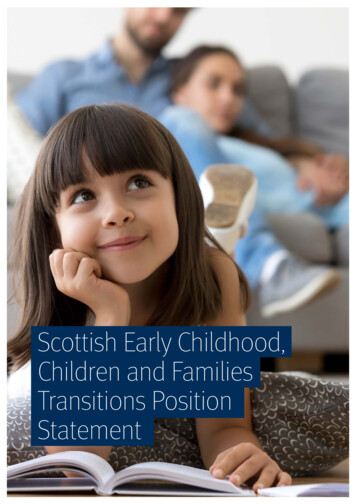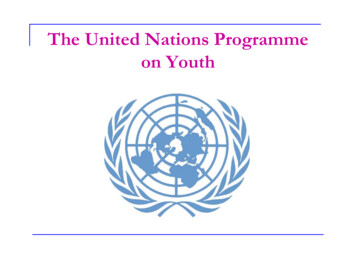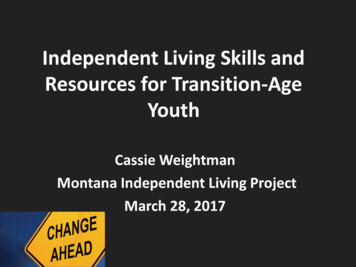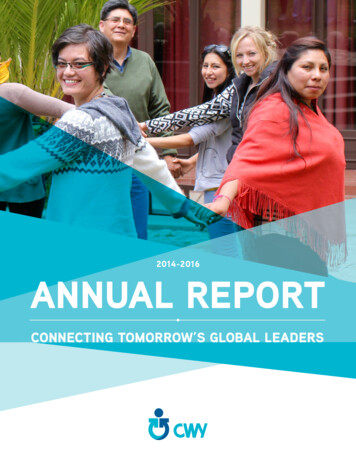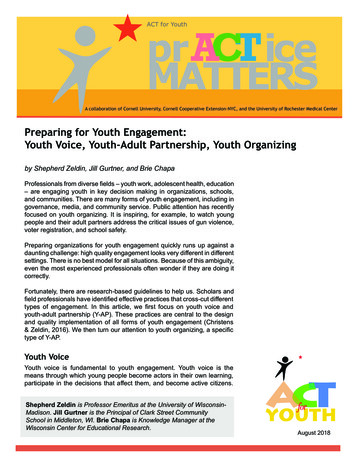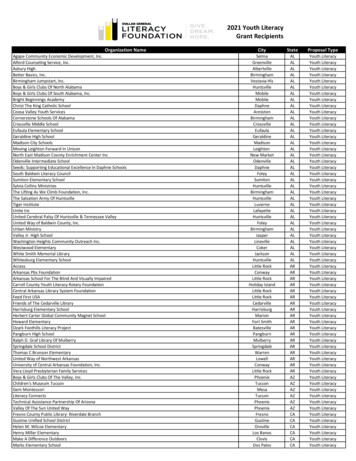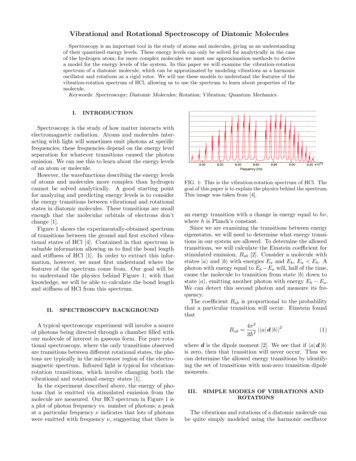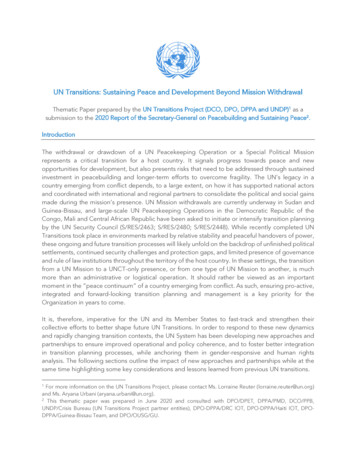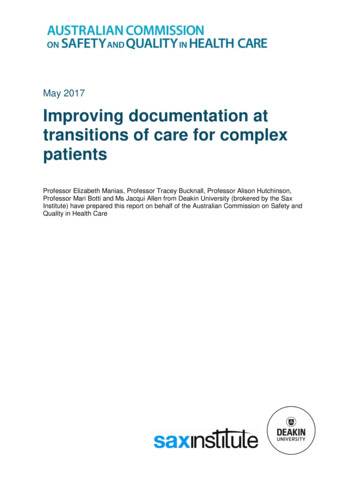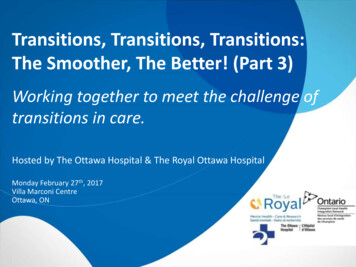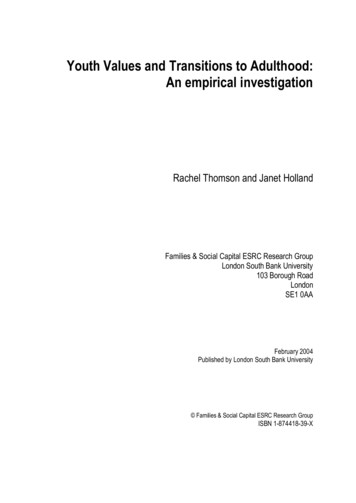
Transcription
Youth Values and Transitions to Adulthood:An empirical investigationRachel Thomson and Janet HollandFamilies & Social Capital ESRC Research GroupLondon South Bank University103 Borough RoadLondonSE1 0AAFebruary 2004Published by London South Bank University Families & Social Capital ESRC Research GroupISBN 1-874418-39-X
Contents1.Introduction22.Youth Values: A study of identity, diversity and social change3Background3Values and social changeYoung people as moral agentsValues, identities and capital333Objectives of the studySample and MethodsSome findings from Youth Values446The structure of youth valuesThe research questions67Conclusion to Youth Values113.13Inventing Adulthoods: Young people’s strategies for transitionBackgroundObjectives of the studySample and MethodsMethods of analysisInterpretation and understandingSome findings from Inventing Adulthoods131316181819The research questionsFrom the individual to the social and back again1919Inventing adulthood? The socially located subject in processEthicsConclusion to Inventing 1.2.3.4.5.6.26Questionnaire for Youth ValuesFocus groupList of statements used in focus groupObservation sheets for focus groupResearch Assignment (printed to facilitate copying)Factor analysis of ethical attitude itemsLifelineList of publications from Youth Values and Inventing Adulthoods13148505456586263
Youth Values and Transitions to Adulthood: An empirical investigationRachel Thomson and Janet Holland1.IntroductionThis paper presents findings from two ESRC funded studies, Youth Values: A study of identity, diversityand social change, and Inventing Adulthoods: Young people’s strategies for transition.1 The twostudies have been followed by a third, Youth Transitions, currently underway in the Families & SocialCapital ESRC Research Group at London South Bank University. The three studies form an initiallyaccidental, but latterly very purposive, longitudinal qualitative study2 following a sample of young peopledrawn from five different sites in the UK. These sites are an inner city site; an affluent area in acommuter town; a disadvantaged housing estate in the north west; an isolated rural village, andcontrasting communities within a Northern Irish city (details in McGrellis et al. 2000). Across the threecomponent studies the major focus for investigation has shifted from values, to adulthood, to socialcapital, but our concern has always been to investigate: agency and the ‘reflexive project of self’(Giddens 1991); values and the construction of adult identity; how the social and material environmentin which young people grow up acts to shape the values and identities that they adopt; and the impactof globalisation on the individual.In the first study we used questionnaires to 1800 young people across the five sites, followed by focusgroups and individual interviews with volunteers from the questionnaire sample. In the second, wemoved into a more dedicated biographical approach documenting how young people constructed theirexpected or desired adulthoods. We selected 116 young people across the sites in the first study, andemployed a range of methods over a period of two and a half years to investigate their understandingsof and strategies for transitions towards adulthood. These included repeat biographical interviews,memory books and lifelines. The third component of the study continues the biographical interviews,and we have just completed a fourth round of interviews with the young people, with a fifth round tofollow in 2004. The young people were between 11 and 18 years at the start and are currently 18-26.This paper reviews the aims and objectives of the first and second studies, and reports some of thefindings and theoretical insights that have emerged. In addition to the references made in the workingpaper, a publications list from the three studies is appended, which includes articles and papers thatfollow up in more detail some of the findings reported here.The paper is drawn from the two final reports on the studies.Details on the three studies are: (1) Youth Values: A study of identity, diversity and social change,ESRC funded on theprogramme Children 5-16: Growing up in the 21st century (L129251020) (McGrellis et al. 2000)(www.lsbu.ac.uk/fahs/ssrc/youth.shtml); (2) Inventing Adulthoods: Young people’s strategies for transition, ESRC funded onthe programme Youth Citizenship and Social Change (L134251008) (Thomson, Henderson and Holland 2003)(www.lsbu.ac.uk/fahs/ff); and (3) Youth Transitions funded as part of the Families & Social Capital ESRC Research Group atLondon South Bank University (Edwards, Franklin and Holland, 2003; Holland, Weeks and Gillies, 2003) (www.lsbu.ac.uk/families).122
2.Youth Values: A study of identity, diversity and social changeBackgroundIn an essay ‘On methods and morals’ A H Halsey (1985) observes that a range of disciplines havebrought many methods to bear on the definition and explanation of values, only ever developing partialand provisional responses to an infinitely complex term. By keeping an open mind about what we meanby values and how they may be defined we tried to situate this study creatively within a divergentliterature in the following way:Values and social changeA body of empirical work has documented movement in values in Western cultures over time,identifying a ‘culture shift’ from material to post material values (Inglehart 1990) and the development ofincreasingly tolerant and individualistic interpersonal morality (Harding et al. 1986, Ashford and Timms1992). This empirical material lends some support to theoretical studies which point to the progressivedecline in the influence of tradition and social institutions in the formation of values, a process variouslydescribed as ‘detraditionalisation’ (Heelas et al. 1996), ‘individualization’ (Beck 1992) and‘disembedding’ (Giddens 1991). A belief in the efficacy and value of the self has grown in parallel withthis decline (Giddens op cit.) with authority increasingly located in the individual, who is responsible formaking decisions about what is right and wrong. Commentators have pointed to the emergence of newethical stories and communities (Weeks 1995, Plummer 1995, Tronto 1993) and warned of risinganxiety. In Bauman’s terms the ethical paradox of the postmodern condition is that it ‘restores to agentsthe fullness of moral choice and responsibility while simultaneously depriving them of the comfort thatmodern self confidence once promised’ (Bauman 1992: xxii).Young people as moral agentsInfluential theorists such as Giddens and Beck point to the erosion of generation as a legitimate markerof authority, but there has been relatively little sociological work that seeks to document or explain thevalues of children and young people within this context. Such studies as exist are primarily descriptive(Roberts and Sachdev 1996, Francis and Kay 1995) or speculative (Wilkinson and Mulgan 1995).There is a body of psychological literature concerned with documenting and theorising the processes ofmoral development in children and young people. This work has developed some important insights onthe importance of age, gender and the relative complexity of a young person’s environment to theirlearning process, but has tended to develop models of moral development that exist outside ofparticular times, cultures and gender relations. Harvey (1993) has observed that attendance to thespecificity of place thwarts the development of meta-theories, and some of the most interesting studiesof the young as moral agents are those that seek to document the processes of identity-making in smallscale local cultures, demonstrating the importance of community (Back 1997), friendships andreputations (Hey 1997), the family (Brannen 1996), and consumption (Miles 1997) as sites of moralmeaning.Values, identities and capitalIn seeking to bridge the gulf between these literatures, we found it useful to think of values asimplicated in beliefs, discourses and identities, but also as representing commodities or resources thatare given worth within particular economies or communities. In understanding value discursively wehave built on the view that sources of moral authority have proliferated, resulting in an ‘aestheticisationof the ethical’ (Tester 1992, Shusterman 1988). Not only has there been a proliferation of moraldiscourses between which one can move in the construction of a moral self (Tronto 1993) but in moving3
between these discourses, or economies, one is involved in the appropriation and transformation ofmeaning. This process has been documented clearly in the field of consumption, where young peoplehave been shown to appropriate and transform the material value of consumer products such ascomputer games. By drawing these games first into the moral economy of the household, and then intothe public sphere through their knowledge, expertise and ability to talk about the games withinfriendship cultures, young people effectively transform their value between different economies(Silverstone et al. 1992). A body of more ethnographic work achieves a similar end by adopting thetheoretical tools of Pierre Bourdieu (1986) (in particular the concepts of social, cultural, material andembodied capital) in order to understand the relationship between what individuals value, theiridentities and their social environments (Skeggs 1997, Connolly 1998, Thornton 1995).Objectives of the study1. To contribute to theory in the area of the social construction of identity by examining how youngpeople position themselves in relation to different contemporary value systems and to understandhow this positioning relates to processes of identity formation including experiences of socialinclusion and exclusion.2. To produce new data providing qualitative and quantitative documentation of the variety ofmoral world views within and between groups of young people aged 11-16 in the UK with particularreference to differences of age, gender, ethnicity, faith, social class, family formation and location.3 To produce knowledge of the factors that contribute to moral development and of the strategiesthat young people employ to cope with moral dilemmas and diversity. We planned to developunderstanding of how social and intergenerational change have affected the legitimacy of sourcesof moral authority for young people.4. To make a major contribution towards youth policy in the areas of health, education, parentingand criminal justice by providing an understanding of young people as active moral agents,documenting the range of their moral world views and elaborating their understanding of morallegitimacy. The study aimed to make a practical contribution to educational practice and methods,and identify potential strategies for the support and guidance of young people from different socialenvironments.Sample and MethodsThe methods demanded a reflexive and incremental research design, encouraging and responding toyoung people’s participation throughout the research process. To do this we: consulted young people initially about the focus and methods of the research throughdevelopmental pilot groups incorporated young people’s own voices, ideas and language into the research tools; were aware of the research process as an ethical intervention into young people’s lives in the‘present tense’ as well as the longer term. This entailed development of participatory researchtechniques, observation and recording of group dynamics, negotiation of ground rules andcareful negotiation of consent.We conducted 5 pilot focus groups in order to achieve these requirements. The methods employed inthe study were questionnaires, focus groups and individual interviews with young people aged between11 and 16, drawn from schools, and further young people aged up to 18 drawn from pupil referral units,4
gay and lesbian groups, and young people in care. The numbers involved for each method were:questionnaire (1800), focus groups (56), and individual interviews (54).The questionnaireThe questionnaire was developed in consultation with the developmental pilot groups who contributedideas to the content, wording and design (see Appendix). We also adapted questions from a number ofexisting studies including the European Values Study (Ashford and Timms 1992), the West of Scotland11-16 Study (Sweeting and West 1995), the British Social Attitudes Young People’s Survey (Robertsand Sachdev 1996) and the ESRC 11-16 Adolescent Identities Study (Banks et al. 1992), which hadthe advantage of allowing comparison with other studies. The questionnaire was administered to 1800young people in eight different schools and in the extra sites. Young people were given the same set ofinstructions across all sites and encouraged to request help from the researchers present as needed.Confidentiality was emphasised as was the fact that responses would not be fed back to teachers orcarers on an individual level. The majority of queries on the questionnaire were on the meaning of a fewquestions: ‘euthanasia’, ‘pornography’, and ‘cloning’. The questionnaire included an evaluation and thecomments made were, on the whole, favourable.3 Some young people, however, felt it was toopersonal: ‘Too personal at the start (demographic questions) I don’t like being asked to give informationabout my family and friends’. A word search at the end of the questionnaire was also popular and was agood time filler for those who completed early.The focus groupThe group discussion method used in the study was an adaptation for research purposes of a gameused in training and personal and social education. The values continuum provides a means forparticipants to ‘explore values and attitudes in a group and to enable participants to acknowledgesimilarities and differences in values’ (Lenderyou 1994:19). This method enabled researchers toobserve group dynamics as well as generate opinion and discussion on relevant themes. Contentiousstatements were given to the group, who were asked to place themselves individually on a continuumfrom ‘strongly agree’ to ‘strongly disagree’, and then discuss together their views. Participants read outthe statements in turn. They included: it’s wrong to have a child unless you can support it’, ‘It’s good tobe different’, ‘older people should be respected’ (see Appendix for list of statements used and fulldescription of the method).Sessions, with between 4-6 participants, were usually one hour long and most were held in schools.Some took place in other locations, for example youth clubs and children’s homes. Two researcherswere present, one facilitator and one observer, and each session began with introductions followed byagreement of ground rules, and clarification of the meaning of confidentiality and anonymity. The entiresession was tape-recorded and coded on NUD*IST to be analysed, and the observer made notes ongroup dynamics and interactions.The individual interviewThe research team themselves engaged in regular sessions of memory work throughout the project(see Crawford et al. 1992) as a mean of developing insight and reflexive awareness about the researchtopic and this work informed the individual interview schedule (Thomson et al. 2003a). The primary aimwas to gain insight into young people’s perceptions of their own process of moral development. Weemployed a biographical approach, asking them to recall their earliest memories of good and bad andthe key people, places and events of their moral development, reflecting on leadership, moral authoritySome comments were: ‘Very thorough and well presented’, ‘Good questionnaire dude’, ‘Thanks this has helped me to beindependent and make my own decisions’.35
and difference in relation to others. Interviews took on average one hour and were tape-recorded.Issues of consent, confidentiality and anonymity were reconfirmed at the start and end of the interview.Data included the transcriptions of interviews and researcher’s field notes.Research assignments and class workResearch assignments were semi-structured interview schedules encouraging young people tointerview an adult about what the world was like ‘when I was your age’. 272 assignments were returnedfrom seven schools. While the administration of the method means that systematic analysis orinterpretation is difficult, the research assignments have been subject to content and qualitativeanalysis and provide us with rich illustrative material (Thomson et al. 2003a). Schools were also invitedto undertake class work in relation to the themes of the research. Again, participation in this methodwas voluntary and we received ‘problem page’ responses from young people in four of the eightschools and creative work based on trigger words from one school.Methods of analysisAll data was transformed into machine-readable form. The quantitative data set was coded, cleanedand subjected to statistical analysis using SPSS PC. Focus group and individual interview data werefully transcribed and coded on NUD*IST. The class work and the research assignments were codedand analysed and linked to the main data set as off-line data. An analysis of the media-related data wasalso undertaken, including a selected content analysis.We drew data from each of our analyses to realise the aims of the study, and here we give some of thefindings from all of these sources, related to our research questionsSome findings from Youth ValuesOur central finding has been that young people have sophisticated value systems and that they aredeeply engaged in the emotional and ethical labour involved in constructing their identities and theirlives. We are able to show and explore this in many ways drawing on data produced by our differentmethods of investigation.The structure of youth valuesBy comparing our questionnaire sample to relevant baseline data we found that these young people’svalues did not differ significantly from those documented for adults. Issues appear to fall into threeareas: those about which there is a consensus (for example the overwhelming majority believe thatstealing, drug taking, racism and joyriding are wrong), those about which there is widespreaduncertainty or diversity in opinion (for example abortion, suicide, euthanasia and pornography) andthose over which there is controversy, i.e. where views are polarised, (for example attitudes towardshomosexuality).Our quantitative analysis enabled us to see how the values of young people differ according to age,gender, social class, location and their orientation towards authority. For example we identified anoverall age pattern where young people’s responses to ethical issues become more circumspect andtolerant with age. On most issues there are small gender differences, with young women tending to beslightly more disapproving than young men. In some areas (including attitudes towards divorce and sexoutside marriage) this pattern is reversed, and in others (such as attitudes towards homosexuality), wefind a polarisation of view taking place along the lines of gender, with boys having more negative views.A factor analysis of responses identified an internal structure to young people’s values, confirming and6
complicating that identified by Ashford and Timms (1992), showing for example that attitudes towards‘Life Issues’ (such as abortion, suicide, euthanasia) not only ‘hang’ together but may be shaped moreby social class than gender or religion. We also found that location had a profound impact on certainvalues, enabling us to identify a discrete structure of values in Northern Ireland as well as significantlocal variations elsewhere. Further discussion of the content of the factors and their relationship to keydemographic data can be found in McGrellis et al. (2000) and a list of the factors appears in theAppendix to this paper.The quantitative data gave us an overview of young people’s values, but also questions with which toapproach our qualitative data. For example, questionnaire responses indicated that the most tolerantattitudes towards drug taking occurred in the rural site and the least tolerant in the inner city site. Wecould make sense of this only through qualitative case studies for example where relative proximity todrugs and related risks may result in more intolerant attitudes, as found in the questionnaire responses(Henderson, 1999). Similarly, the identification of dramatic gender differences in sexual values in themiddle-class commuter belt site and their relative absence in the isolated estate provided a route intomapping the contrasting economies of values of the two communities and the place of early parenthoodwithin this (Thomson 2000a, Sharpe 2001). Below we briefly report those findings most directly relatingto our original research questions, drawing on all our sources of data as relevant.The research questions1. What or who do young people recognise as sources of moral authority and what factors contribute tothe legitimacy of moral authority? (related to objective 3 above)Distinguishing power and authorityAuthority has been described as power with legitimacy, i.e. power that needs neither to be explainednor defended (Rose 1996). We found that young people were questioning the legitimacy of many formsof power. The line between legitimate and illegitimate power in young people’s moral worlds is complexand contested - most tended to distinguish their own personal morality, the values of their particularfriendship groups, the informal and formal values of the school and the values of the wider culture.While they were able to exercise some degree of control over the first two levels, they experiencedthemselves as subject to systems of collectively enforced values that informed the maintenance ofreputations, popularity and fashion. Young people also distinguished between value systems (usuallyembedded within rules) that were formal and accountable and those that were informal and assumed.Traditional authority figures, such as the police, religious leaders and the royal family received very littleautomatic respect from young people. They explained that respect must be earned, authority won andmerit proven. This ethic of reciprocity was particularly apparent in young people’s discussion of thepurpose and application of school rules and the behaviour of teachers. While young people did notalways invest teachers with moral authority, they watched them closely to see if they were worthy of it.The factors that contribute in young people’s view to being a ‘good teacher’ provide insight into thefactors that they see as contributing to the legitimacy of moral authority, such as consistency, care, theability to listen and practical skills.The individualisation of authority?The sources of moral authority recognised by young people are consistent with (an uneven) shift fromtraditionally ascribed authority to its negotiation and location in the individual. Young people were quickto defend their moral autonomy, stressing self-determination, but the legitimate moral agent (self orother) could be complicated. First, the moral self was also understood as the ‘true’ self and young7
people talked a great deal about the need to pursue self-knowledge and authenticity in friendships andas individuals. It is also possible to identify a tension in young people’s discourse between an assertionof moral individualism and a lived morality in which they are implicated in structures, identities andloyalties that transcend the individual. An example of such tensions can be found in young people’srelationship with the cultural authority of the media. Young people tended to deny suggestions that theywere influenced by the media, since it implied lack of agency or independence. Negative influence fromthe media was more likely to be mentioned when young people took on an adult position in relation toyounger siblings, in stories of younger brothers and sisters acting out sequences or fantasies fromcartoons, movies and games. But in less direct discussions, the media emerged with a significant placein their own moral landscapes - as a source of information, a resource for the development of moralidentities, and a source of pre-packaged moral discourses.The family as a haven of obligationAs a group parents were the most respected and unquestioned sources of authority, and of parents,mothers the most commonly admired and defended. In many ways parents and the family appeared tobe relatively exempt from the reworking of authority that is evident more widely. While there is someevidence that young people are compelled to renegotiate family relationships (Finch and Mason 1993)from necessity (through family conflict) or choice (friendship relationships with mothers) they tend todescribe the family in terms of its difference from wider relationships based on choice, consent or moreexplicit relations of authority. So parents have the right to hit children, there is an obligation to fight forfamily honour, you can only really trust family members, and ‘telling’ is honourable only when it involvesthe family. A number of those in our study were alienated from their families, either living away fromhome independently or in the care of the local authority. Yet in most of these cases moral authority wasstill attributed to the family of origin, particularly in response to the alternative assertion of authority bythe state in the form of social workers. The one exception to this was in the case of a group of lesbianand gay young people where the notion of a ‘community’ and ‘a family of choice’ (Weeks, Donovan andHeaphy 1999, 2001) was posed as a positive alternative. Whether or not these ideals translated intopractice, the family clearly played a symbolic role in moral landscapes - a haven of obligation in a worldof choice (see Sharpe 2001 and 2004 forthcoming).2. How do they perceive changes in values across generations? (see objectives 1 and 3)We asked young people to undertake research assignments, interviewing a significant adult aboutchanges and continuities between the worlds of their childhood and now. In focus group discussionsand in the questionnaire we asked young people about their hopes and fears for the future.Narratives of loss and gainMany of the same themes characterise the accounts of adults and young people. Most are doubleedged, speaking of both loss and gain, with the voices of the young accentuating the positive. One keytheme identified by both was change to the family. On a positive note a greater openness in relationsand communications between parents and children, and greater equality between the genders in termsof leisure and freedom was observed. On the negative side an erosion of parental authority, familybreakdown, sexual pressure and lack of family time were mentioned. The condition of ‘kids today.’ wasa way in which adults identified wider changes related to consumption, authority, and gender equality.Notions such as ‘children today have no respect’, ‘have too much freedom’, ‘are spoiled for choice’,simultaneously grieved a lost golden age while expressing concern about new risks faced by the young.Both young and old expressed positive views about improvements in the quality and standards ofeducation. Continuities were discussed less frequently and in less detail than changes, and includedcomments on the enduring structures of everyday life - schooling, work and family life.8
In discussions we found that young people were able to move within and between these narratives ofloss and gain, taking up different positions, observing decline as well as progress, attributing blame aswell as asserting hope. Their hopes speak of continuities between the generations. Young peoplegenerally wanted to find love (often marriage), have children, a steady job, and good health forthemselves and their families. While most young people’s hopes and fears centre on those things overwhich they felt they have some control, they are particularly fatalistic and resigned about those they seeas beyond their control, such as the politics of the environment, the peace process in Northern Ireland,the economy. It is here rather than in the intimate spheres of family life and friendships that youngpeople blame adults, expressing frustration with their failures, their ‘short termism’ and their greed.3. How do they respond to diversity in contemporary value systems? (see objectives 1, 2 and 3)We approached this question in a number of ways: Young people experience diversity very differentlyaccording to where and how they grow up. Pilot work exploring the language of values revealeddramatic differences in the linguistic repertoires available to young people for moral discourse. Whileyoung people in the inner city site generated an excess of words for making judgements of right andwrong, and expressing ambivalent positions in between, young people in our rural site were able toreport few such words. The different levels of complexity of language in these two sites could be seenas reflecting the relative complexity of the moral worlds they represent: the former a varied, sociallymobile community, ethnically diverse and relatively privatised beyond the shared spaces of schools andshops; the latter an ethnically homogeneous, relatively stable community where all are known to eachother. The young people could appear inconsistent, but we theorised that they were able to switchbetween value regimes; a strategy for dealing with diversity. For example, discussing issues ofparenting, such as whether it is appropriate to have a child if you cannot support it, we found that youngpeople moved between value regimes of personal choice and self-sufficiency, and within regimesbetween the subject position of the child to that of the parent and back. Rather than acting to resolveethical uncertainty and complexity, young people’s moral discourse tende
2 Youth Values and Transitions to Adulthood: An empirical investigation Rachel Thomson and Janet Holland 1. Introduction This paper presents findings from two ESRC funded studies, Youth Values: A study of identity, diversity and social change, and Inventing Adulthoods: Young people's strategies for transition.1 The two studies have been followed by a third, Youth Transitions, currently .
